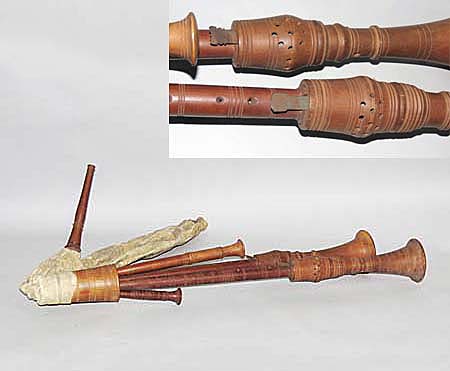
Owner: HWMC
Catalog#: CL-AERV-52-14
Provenance: Speed Art Museum, Louisville, Kentucky – Donated to museum from Mrs. Hattie Bishop in 1928
Free Reeds - Bagpipes
Bagpipe: “Zampogna a chiave”- Italy
Calabria, Italy
Bagpipe
Wood, hide, metal, reed
18th century
Wind Instruments – Woodwind Instruments – Free Reed – Bagpipes
This zampogna is a bagpipe of the southern part of Italy, particularly in Calabria. It is known as the “zampogna a chiave” (zampogna with key), which belongs to the most pure tradition of the Molise region of Italy. The zampogna has a bright and powerful sound rich in overtones. Types of zampogna bagpipes in central and southern Italy are distinguished by their timbre, tuning, size, number of pipes, and types of materials used. Characteristic of this 1700s ‘zampogna’ is the four unequal pipes, two chanters and two drones each with double reeds and each with a conical bell at the end. The first chanter is a soprano chanter called ‘ritta’ and is played by the right-hand fingers. The second chanter is a long bass chanter called ‘manca’ with four tone-holes and the last one is covered with a metallic key (from which the epithet “a chiave”). It is played by using the left hand. The first drone is called “bordone.” The second drone is the smallest pipe and is called “fischietto” (literally little whistle).
The air is supplied by a bag (made of goat skin) that is held under the player’s right arm. The player blows a steady flow of air through reeds of all pipes by maintaining a constant pressure on the bag with the elbow. A key difference between zampogna and other bagpipes is its polyphonic capabilities due to the number of pipes with all the pipes planted in the same wood block connected to the bag.
This deaccessioned zampogna was described as a Calabrain Bagpipe, 18th century by the Speed Art Museum, Louisville, Kentucky.
